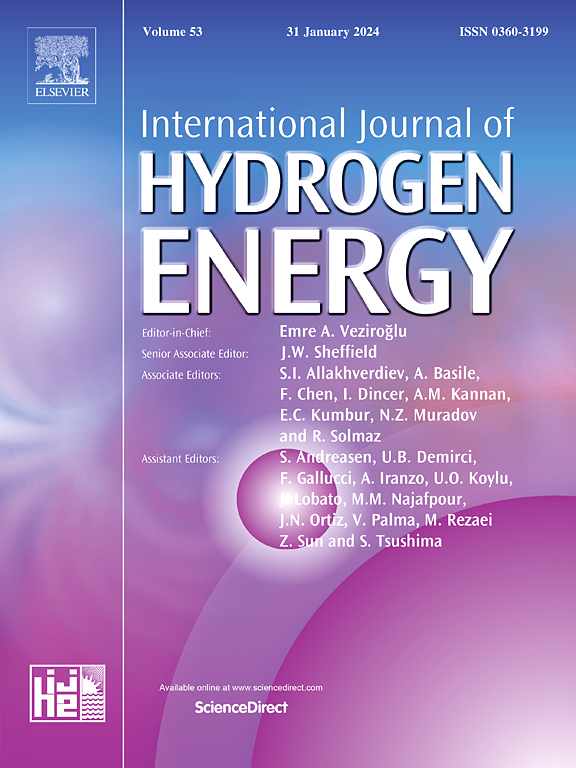作为染料降解和制氢催化剂的双功能富硒生物质活性炭的光催化性能
IF 8.1
2区 工程技术
Q1 CHEMISTRY, PHYSICAL
引用次数: 0
摘要
在这项工作中,合成了大麻衍生生物炭(BC),然后用 KOH 活化,得到了活性炭(AC)。硒(Se 1、3、5 wt%)被负载在 AC 上,并使用各种技术对其进行表征,以研究其作为双功能光催化剂在降解染料和产生 H2 方面的物理化学、电化学和光催化性能。研究了 BC、AC 以及不同硒负载量(1 wt%、3 wt%、5 wt%)对日光下降解水晶紫(CV)染料的影响。在 3% 的 Se-AC 中,CV 染料在 75 分钟内的降解效率最高(98.2%),并且在活性自由基陷阱测试中,电子(e-)对 CV 的降解有主要贡献。测试了光催化产生 H2 的性能,结果表明 3% Se-AC 的最大 H2 产生率为 3095 μmol/g/h,光对氢的效率(LTH)为 2.36%。反应后的表征显示了竞争稳定性。提出了光催化产生 H2 的可能反应机理,并认为硒负载在电荷转移增强中发挥了关键作用,因为硒具有高极化性和丰富的 d 电子,而且其与氢原子的键能(Se-Hads 为 273 kJ/mol)与铂(Pt)(Pt-Hads 为 251 kJ/mol)相当。本文章由计算机程序翻译,如有差异,请以英文原文为准。

Photocatalytic performance of dual-function selenium-enriched biomass-derived activated carbon as a catalyst for dye degradation and hydrogen production
In this work, hemp-derived biochar (BC) was synthesized and then activated with KOH to achieve activated carbon (AC). The selenium (Se 1, 3, 5 wt%) was loaded over AC and characterized using various techniques to investigate the physicochemical, electrochemical, and photocatalytic performance for dye degradation and H2 generation as dual function photocatalyst. BC, AC, and the influence of different loading of Se (1 wt%, 3 wt%, 5 wt%) were examined for the degradation of crystal violet (CV) dye under sunlight. Amongst 3% Se-AC showed the maximum degradation efficiency (98.2%) of CV dye within 75 min and the electrons (e−) had a major contribution to the degradation of CV during the active radical trap test. The photocatalytic H2 production performance was tested and the maximum H2 rate 3095 μmol/g/h and light to hydrogen efficiency (LTH) 2.36% were achieved for 3% Se-AC. The post-reaction characterization showed competitive stability. A possible reaction mechanism was proposed for photocatalytic H2 production and it is suggested that the Se loading played a key role in charge transfer enhancement due to high polarizability, d-electron richness, and its bond energy with hydrogen atoms (Se-Hads is 273 kJ/mol) is comparable to the platinum (Pt) (Pt-Hads is 251 kJ/mol).
求助全文
通过发布文献求助,成功后即可免费获取论文全文。
去求助
来源期刊

International Journal of Hydrogen Energy
工程技术-环境科学
CiteScore
13.50
自引率
25.00%
发文量
3502
审稿时长
60 days
期刊介绍:
The objective of the International Journal of Hydrogen Energy is to facilitate the exchange of new ideas, technological advancements, and research findings in the field of Hydrogen Energy among scientists and engineers worldwide. This journal showcases original research, both analytical and experimental, covering various aspects of Hydrogen Energy. These include production, storage, transmission, utilization, enabling technologies, environmental impact, economic considerations, and global perspectives on hydrogen and its carriers such as NH3, CH4, alcohols, etc.
The utilization aspect encompasses various methods such as thermochemical (combustion), photochemical, electrochemical (fuel cells), and nuclear conversion of hydrogen, hydrogen isotopes, and hydrogen carriers into thermal, mechanical, and electrical energies. The applications of these energies can be found in transportation (including aerospace), industrial, commercial, and residential sectors.
 求助内容:
求助内容: 应助结果提醒方式:
应助结果提醒方式:


